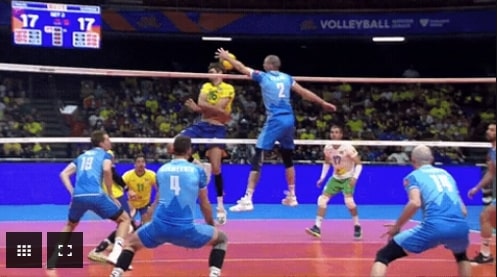Different Types of Blocking in Volleyball

Blocking is a fundamental skill in volleyball that can significantly impact the outcome of a game. It is a defensive play intended to stop or slow down an opponent’s attack by intercepting the ball at the net. Effective blocking not only prevents the ball from entering the defensive team’s court but also can turn defense into offense by creating opportunities for a counterattack.
There are various types of blocking techniques in volleyball, each with specific strategies and purposes. In this article we’ll look at the different types of blocking and their importance in the game.
Basic Block
The basic block is the fundamental blocking technique every player learns. It involves jumping near the net with arms extended upward, aiming to intercept the ball as it crosses the net. The primary components of a basic block include timing, positioning and hand placement.
When performing a basic block, players must be vigilant and ready to react quickly. As the opponent prepares to hit the ball, blockers need to watch the hitter’s body language and arm swing. Timing is crucial; players must jump at the right moment to meet the ball at its highest point.
Positioning is equally important, as blockers should align their bodies directly in front of the hitter to maximize their blocking area. Proper hand placement involves reaching over the net with fingers spread wide, creating a larger surface area to intercept the ball and potentially direct it back into the opponent’s court.
Key Elements of Basic Block
| Element | Description |
|---|---|
| Timing | Jumping at the right moment to meet the ball at its highest point. |
| Positioning | Aligning the body correctly in front of the attacker to maximize block area. |
| Hand Placement | Hands over the net, fingers spread wide to cover more surface area. |
Single Block
A single block is performed by one player and is typically used when the blocker can handle the attacker alone. This type of block is common when there is a physical mismatch, such as a taller blocker facing a shorter hitter.
A single block requires exceptional skill and anticipation. The solo blocker must carefully read the setter’s intentions and the hitter’s approach to the ball. Once the set is made, the blocker must quickly position themselves in front of the hitter, ensuring their jump is perfectly timed.
The solo blocker’s hands and arms must be precisely placed to intercept the ball effectively. While this technique can free up other players for backcourt defense, it puts considerable pressure on the blocker to succeed, as there is no backup if the block fails.
Advantages and Challenges of Single Block
| Advantages | Challenges |
|---|---|
| Frees up other players for defense | Requires excellent timing and anticipation. |
| Quick and efficient | No backup if the blocker misses the block. |
Double Block
A double block involves two players jumping together to create a larger barrier. This is the most common form of blocking, especially against powerful hitters.
The effectiveness of a double block lies in the coordination between the two blockers. They must communicate and move in unison, ensuring their hands and arms are aligned to cover as much space as possible. The blockers’ objective is to reduce the angles available to the hitter, making it more difficult to find gaps in the defense.
The double block is particularly effective against strong outside and middle hitters, as it provides a more substantial barrier and increases the likelihood of a successful block or deflection.
Coordination and Coverage in Double Block
| Aspect | Description |
|---|---|
| Coordination | Both blockers must synchronize their movements to maximize the blocking surface. |
| Coverage | Reduces the angles available to the hitter, increasing the chance of a successful block. |
Triple Block
A triple block is used in high level volleyball, involving three front row players. This is typically employed against a dominant hitter or in critical game situations.
Executing a triple block requires exceptional teamwork and precise timing. All three blockers must jump together, aligning their arms and hands to create an almost impenetrable wall. This technique is highly effective against top tier hitters who pose a significant threat. However, the triple block comes with risks.
Committing three players to the block leaves other areas of the court exposed, requiring the back row to cover a larger area. Despite this, the sheer size and power of a triple block can be a game changer in crucial moments.
Pros and Cons of Triple Block
| Pros | Cons |
|---|---|
| Creates an almost impenetrable barrier | Leaves other areas of the court more exposed. |
| Highly effective against top tier hitters | Requires perfect timing and coordination among three players. |
Soft Block
A soft block, also known as a controlled block, is used to deflect the ball in a way that makes it easier for the defenders to handle. Instead of attempting to stop the ball outright, the blocker aims to reduce its speed and direct it to a teammate.
Performing a soft block requires a delicate touch and precise control. Blockers aim to contact the ball lightly, absorbing some of its momentum to decrease its speed. This technique is particularly useful against hard hitters, where blocking the ball directly might be difficult or result in the ball going out of bounds.
The soft block redirects the ball into the backcourt, making it easier for teammates to set up a counter attack. This approach emphasizes strategy and control over sheer power.
Technique and Use Case for Soft Block
| Technique | Use Case |
|---|---|
| Requires gentle, controlled hands | Effective against powerful, hard hitters. |
| Focuses on redirecting the ball | Allows for strategic defense transitions. |
Swing Block
Swing blocking involves a more dynamic and explosive motion compared to traditional blocking techniques. Players use a swinging arm motion to gain more height and momentum.
Swing blocking requires advanced footwork and coordination. The blockers begin with a lateral step, followed by a crossover step and then a powerful jump with an arm swinging motion to maximize reach and penetration. This technique provides greater height and allows blockers to move more quickly along the net, making it particularly effective against high, fast attacks.
Swing blocking demands precise timing and coordination between teammates to ensure they cover the necessary areas without leaving gaps. The dynamic movement and additional momentum can help the blockers reach balls that would otherwise be difficult to intercept.
Footwork and Advantages of Swing Block
| Footwork | Advantages |
|---|---|
| Lateral step, crossover step, powerful jump | Greater reach and power, effective against high, fast attacks. |
Penetration Block
A penetration block involves reaching the hands over the net and into the opponent’s court as much as possible, aiming to intercept the ball at its highest point and direct it downwards.
This block technique emphasizes aggressiveness and dominance at the net. By penetrating deeply into the opponent’s court, blockers can cut off the attack closer to its source, reducing the hitter’s angles and increasing the chance of a stuff block (a block that results in an immediate point).
The key to a successful penetration block is proper hand positioning and timing to avoid net violations while maximizing effectiveness. This technique often intimidates hitters and disrupts their rhythm, forcing them to make errors or choose safer, less aggressive shots.
Technique and Timing in Penetration Block
| Technique | Timing |
|---|---|
| Emphasizes reaching over the net | Critical to avoid net violations and maximize block effectiveness. |
Commit Block
In a commit block, a blocker decides to jump with the hitter regardless of the set’s location. This is often used against strong middle hitters.
Commit blocking involves a high level of anticipation and pre-match analysis. The blocker, based on scouting reports or in-game observations, commits to a particular hitter, usually the middle attacker, anticipating where the set will go. This preemptive strategy can disrupt quick attacks and put pressure on the hitter.
However, the risk is significant: if the set goes to a different hitter, the commit blocker is out of position, leaving the defense vulnerable. Thus, successful commit blocking requires thorough knowledge of the opponent’s tendencies and excellent communication within the team.
Decision Making in Commit Block
| Aspect | Description |
|---|---|
| Based on reading setter/hitter | Pre-planned move, disrupts quick attacks if correctly anticipated. |
| Risk of misreading | Can leave gaps if the set does not go as expected. |
Read Block
A read block, or reactive block, involves the blocker watching the set and the hitter’s approach before deciding where to jump.
Read blocking is a highly reactive and flexible technique. Instead of committing to a specific hitter or set location, the blocker waits and observes the setter’s and hitter’s movements. Once the set is made, the blocker quickly moves to position themselves in front of the hitter.
This approach requires excellent reading skills, quick reflexes and agility. The read block is versatile and can adjust to different attacking scenarios, making it a valuable skill at all levels of play. However, it requires exceptional discipline and concentration to execute effectively.
Observation and Flexibility in Read Block
| Aspect | Description |
|---|---|
| Observation | Requires excellent reading of the game and quick reflexes. |
| Flexibility | Allows adjustments based on the set and hitter’s position, making it versatile. |
Conclusion
Blocking in volleyball is a multifaceted skill that requires a combination of technique, timing and strategy. Each type of block—whether it’s a basic, single, double, or triple block; a soft or swing block; or a penetration, commit, or read block—has specific applications and advantages.
Mastering these different types of blocking allows teams to create a formidable defense, disrupt opponents’ attacks and gain a tactical edge in the game. As players progress in their volleyball careers, understanding and effectively implementing these blocking techniques become essential components of their defensive arsenal.
By diversifying their blocking strategies, volleyball teams can adapt to various offensive plays, enhance their defensive prowess and ultimately, increase their chances of winning matches. Whether employing the penetrating power of a swing block or the strategic anticipation of a commit block, the art of blocking remains a cornerstone of effective volleyball defense.


